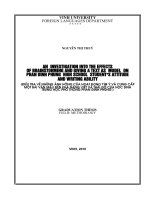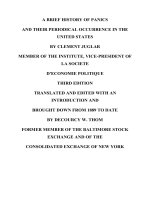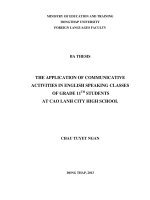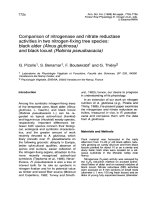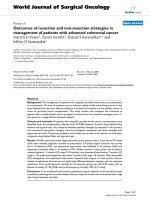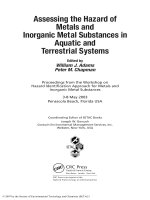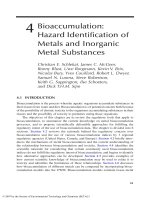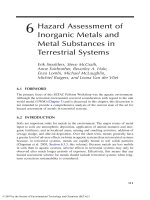Twelfth graders perceptions of communicative and non communicative activities in EFL classroms in bac ly high school
Bạn đang xem bản rút gọn của tài liệu. Xem và tải ngay bản đầy đủ của tài liệu tại đây (1.14 MB, 54 trang )
VIETNAM NATIONAL UNIVERSITY, HANOI
UNIVERSITY OF LANGUAGES AND INTERNATIONAL STUDIES
FACULTY OF POST-GRADUATE STUDIES
--------------------
NGUYỄN THỊ THU HƢƠNG
TWELFTH GRADERS’ PERCEPTIONS OF
COMMUNICATIVE AND NON-COMMUNICATIVE
ACTIVITIES IN EFL CLASSROOMS
IN BAC LY HIGH SCHOOL
(Nhận thức của học sinh lớp 12 về các hoạt động giao tiếp
và phi giao tiếp tại trường Trung học phổ thông Bắc Lý)
M.A. MINOR PROGRAMME THESIS
Field: English Teaching Methodology
Code: 60.14.10
HANOI – 2011
VIETNAM NATIONAL UNIVERSITY, HANOI
UNIVERSITY OF LANGUAGES AND INTERNATIONAL STUDIES
FACULTY OF POST-GRADUATE STUDIES
--------------------
NGUYỄN THỊ THU HƢƠNG
TWELFTH GRADERS’ PERCEPTIONS OF
COMMUNICATIVE AND NON-COMMUNICATIVE
ACTIVITIES IN EFL CLASSROOMS
IN BAC LY HIGH SCHOOL
(Nhận thức của học sinh lớp 12 về các hoạt động giao tiếp
và phi giao tiếp tại trường Trung học phổ thông Bắc Lý)
M.A. MINOR PROGRAMME THESIS
Field: English Teaching Methodology
Code: 60.14.10
Supervisor: Dr. Tô Thị Thu Hƣơng
HANOI - 2011
iv
TABLE OF CONTENTS
page
DECLARATION OF ORIGINALITY
i
ACKNOWLEDGEMENTS
ii
ABSTRACT
iii
TABLE OF CONTENTS
iv
LIST OF ABBREVIATIONS
vi
LIST OF TABLES AND CHARTS
vii
PART A: INTRODUCTION
1. Rationale of the study
1
2. Aims and Objectives of the study
2
3. Research Questions
2
4. Scope of the study
2
5. Methods of the study
3
6. Significance of the study
3
7. Structure of the study
4
PART B: DEVELOPMENT
CHAPTER 1: LITERATURE REVIEW
1.1 Theoretical background of Communicative Language Teaching (CLT)
6
1.1.1 Definitions of CLT
6
1.1.2 Characteristics of communicative language teaching
7
1.2 Communicative and non-communicative activities in language teaching
and learning process
8
1.2.1 Definition of communicative and non-communicative activities
8
1.2.2 Characteristics of communicative and non-communicative activities
9
1.2.3 Roles of communicative activities in language teaching and learning
10
1.2.4 The roles of teachers in communicative activities
11
1.2.5 Types of communicative activities
12
v
1.3 Students’ perceptions of communicative and non-communicative
activities
14
1.4 Summary
15
CHAPTER 2: METHODOLOGY
2.1 Research approach
17
2.2 Research setting
17
2.3 Subjects
17
2.4 The Textbook English 12
19
2.5 Data collection instruments
20
2.6 Procedures of data collection
21
2.7 Procedures of data analysis
22
CHAPTER 3: RESULTS AND DISCUSSION
3.1 Students’ perceptions of communicative and non-communicative activities
23
3.1.1 Students‟ preference of communicative and non-communicative
activities
23
3.1.2 Students‟ opinions of the usefulness of these activities
27
3.2 Students’ perceived difficulties in practicing communicative activities
29
3.2.1 Low English proficiency
29
3.2.2 Traditional learning styles and habits
30
3.2.3 Little motivation for communicative competence
31
3.2.4 EFL settings
31
CHAPTER 4: IMPLICATIONS AND RECOMMENDATIONS
4.1 To MOET, DOET
33
4.2 To teachers
34
4.3 To students
37
PART C: CONCLUSION
38
REFERENCES
40
APPENDICES
I
vi
LIST OF ABBREVIATIONS
CLT
=
Communicative Language Teaching
DOET
=
Department of Education and Training
ELT
=
English Language Teaching
L2
=
Second Language
MOET
=
Vietnamese Ministry of Education and Training
SLA
=
Second Language Acquisition
vii
LIST OF TABLES AND CHARTS
page
Table 1: Students‟ enjoyment of non-communicative activities
24
Table 2: Students‟ enjoyment of communicative activities
24
Table 3: Students‟ opinions of the usefulness of non-communicative activities
28
Table 4: Students‟ opinions of the usefulness of communicative activities
28
Chart 1: Students‟ difficulties in practicing communicative activities
30
1
PART A- THE INTRODUCTION
1. Rationale of the study
The field of second or foreign language teaching has undergone many paradigmatic
shifts and methodological trends over the last few decades. We have seen the Audiolingual
Method, Cognitive-based Approaches, the Total Physical Response, the Natural Approach,
Communicative Language Teaching and many others. Within the debate on English
teaching methodology, the study of Vietnamese students‟ response to CLT, especially
classroom activities deserves particular attention. Do they enjoy activities involving
communication and real use of language? Do they agree that real language activities
emphasizing language content are more effective than non-communicative activities that
stress formal correction? Do they believe that such activities are helpful to them as
language learners? Do they face with any difficulties in practicing these activities?
According to Kumaravadivelu (1991, p. 107) "the more we know about the
learner's personal approaches and personal concepts, the better and more productive our
interactions will be." We as teachers should be aware of our students' perceptions and
beliefs about language learning in order to facilitate desired learning outcomes in the
classroom. As suggested by Bada and Okan (2000), there is a need for closer cooperation
between students and teachers. It is important to remember that learners already critically
evaluate what they do (Breen, 1989). Teachers can use different strategies to build learners
choices into their lessons. Teachers and students can have a dialogue and negotiate
alternatives, which would definitely lead to more learner involvement and could, therefore,
lead to more positive attitudes towards language learning. As teachers, at every single
moment, we should observe our students' reactions and consider their attitudes and
preferences in order to promote a more inclusive climate that will enhance learning. In
order to deepen our understanding of how students react to communicative and noncommunicative activities, Barkhuisen (1998:86) has called for “teachers to discover their
learners‟ feelings and beliefs about their language learning experiences and consequently
to review and possibly change their teaching process”.
Moreover, Vietnamese high school syllabi now keep promoting CLT in an attempt
to enable the students to use the target language for communicative purposes instead of
mastering its grammatical rules and structures. Vietnamese twelfth graders in upper
secondary school had five-year experience studying English “communicatively” as English
2
is among the compulsory subjects at secondary schools. However, the fact is that after
those years of learning English, not many pupils have a clear cut purpose of learning
English in their mind and they are likely passively motivated to learn English basing on
the textbooks and teachers‟ method of delivery. Consequently, most of pupils find
themselves unable to use English for day-to-day communication after having passed the
English national examination as a requirement for the General Education Diploma.
In brief, all of the reasons mentioned above have inspired the present study on:
“Twelfth graders’ perceptions of communicative and non-communicative activities in
EFL classrooms in Bac Ly high school” as the title for the thesis in the hope that I can
contribute a small part in helping my students and my colleagues to improve their learning
and teaching English.
2. Aims and objectives of the study
With the above-presented rationales, the specific aims and objectives of the study
are the followings. Firstly, the study carries out an investigation into twelfth grade
students‟ perceptions of communicative and non-communicative activities in terms of
preference and usefulness. Secondly, through the investigation the research will find out
the difficulties the students encounter in practicing communicative activities. Thirdly, the
study will provide possible solutions to these difficulties, thereby improving the quality of
English language education in the context of an urban high school.
3. Research Questions
1. What are twelfth graders’ perceptions of communicative and non-communicative
activities in the EFL classrooms?
2. What are students’ perceived difficulties in practicing communicative activities?
3. What are the possible solutions to these difficulties?
4. Scope of the study
Due to time constraint, the study limits itself to the investigation on twelfth graders‟
perceptions of non-communicative and communicative activities in EFL classroom in the
context of an urban high school, Bac Ly high school. Therefore, subjects of the study were
3
teachers of English and students in the twelfth form at Bac Ly high school in Ha Nam
province. Within the scope of the study, the following issues were addressed:
-
Students‟ preference of communicative and non-communicative activities
(Research question 1)
-
Students‟ opinions of the usefulness of communicative and non-communicative
activities (Research question 1)
-
Students‟ difficulties in participating in communicative activities (Research
question 2)
-
Implications and recommendations for overcoming these difficulties (Research
question 3)
5. Methods of study
In this study, a mix of quantitative and qualitative methods were utilized. A
questionnaire survey was conducted on a sample of students to find answers to research
questions 1 and 2. Furthermore, in order to address the limitations of the questionnaire in
exploring students‟ perceptions, and to find out their constraints and possible solutions
(research questions 3), student semi-structured interviews and teacher group discussions
were conducted following the analysis of the questionnaire data.
Questionnaire
data
were analyzed quantitatively for descriptive statistics while the interview and discussion
data were processed qualitatively following an “interpretive model” (Hatch 2002) for
recommended solutions. The answers to three research questions provided a picture of
students‟ perceptions of communicative and non-communicative activities as well as their
difficulties in doing communicative activities in EFL classrooms and possible solutions.
6. Significance of the study
English is used more and more to communicative throughout the world. MOET have
provided a series of new textbooks in order to develop students‟ communicative
competence. It is said that the textbooks are more useful than the older version, but most of
students hardly communicate in English after graduating from high schools and that
teachers and authors should adapt and revise these books. In such a circumstance, the
findings will hopefully aid teachers in their choice of classroom activities and in deciding
4
how learning activities should be arranged and implemented in the classroom while
waiting for MOET to make some changes in these books.
Although the study is intended to investigate students‟ perceptions of noncommunicative and communicative activities in EFL classrooms in an urban high school,
which is not researched adequately in the context of Ha Nam-based high schools, the
outcome of the study can contribute significantly to our understanding of the issue in high
schools with a similar context. As such, this study will serve as a reference material not
only for teachers of English in Bac Ly high school but also for teachers elsewhere who
wish to continually improve the quality of teaching and learning English.
7. Structure of the Thesis
This paper is divided into three main parts:
Part A is the INTRODUCTION. In this part, the rationales of the study, the aims,
research questions, the scope of the study, methods of the study and also its design are
presented.
Part B is the DEVELOPMENT which includes 4 chapters.
Chapter I, Literature Review, deals with a theoretical background about the
definitions of CLT and its characteristics; definitions, characteristics, roles, types of
communicative and non-communicative activities in the process of learning and teaching;
the roles of the teacher in communicative and non-communicative types of communicative
activities, and previous studies on students‟ perceptions about classroom activities.
Chapter II, Research Methodology, describes the situation where the study was
conducted and the informants involved in the study. It includes the teachers of English, the
students, and the textbook. The data collection instruments, procedures of data collection
and data analysis were also presented in this chapter.
Chapter III, Results and Discussion, presents and discusses the results finding
out the students‟ perceptions of communicative and non-communicative activities and their
difficulties in participating in communicative activities.
Chapter IV, Implications and Recommendations, presents some pedagogical
implications of the study and suggestions for overcoming difficulties in practicing
communicative activities in the way, which helps students develop their communicative
competence in Bac Ly high school.
5
Part C is the CONCLUSION which summarizes the main points of the study, limitations
and suggests for further research.
REFERENCES and APPENDICES are presented in the last pages of the study.
6
PART B DEVELOPMENT
CHAPTER I: LITERATURE REVIEW
This chapter reviews the literature on Communicative Language Teaching (CLT), and
previous studies on students‟ perceptions of non-communicative and communicative
activities. First, it presents definitions and the main characteristics of CLT that is followed
by a discussion of con-communicative and communicative activities in language teaching
and learning process. Finally, it presents previous studies on students‟ perceptions of noncommunicative and communicative activities.
1.1. Theoretical background of Communicative Language Teaching (CLT)
1.1.1. Definitions of CLT
Despite the widespread advocacy of CLT, there is a lack of agreement about what
communicative is. According to Harmer (1981: 165): “In the teaching and learning and
methodology of a foreign language, it is only activities within the syllabus and
methodology that can be classed as communicative”.
According to Lightbown & Spada (1999:172), “CLT is based on the premise that
successful language learning involves not only a knowledge of the structures and forms of
the language, but also the functions and purposes that a language serves in different
communicative settings. This approach to teaching emphasizes the communication of
meaning over the practice and manipulation of grammatical forms (emphasis added).”
This definition as it can reflect the nature as well as the target of CLT. CLT focuses not
only on forms but also on meaning. When CLT is successfully applied, students feel very
confident in different communicative contexts.
According to Richards and Rodgers (2001) CLT which is generally regarded as an
approach to language teaching means little more than an integration of grammatical and
functional teaching. As such, CLT reflects a certain model or research paradigm, or a
theory (Celce- Murcia 2001). It is based on the theory that the primary function of
language use is communication. Its primary goal is for learners to develop communicative
competence (Hymes 1971), or simply put, communicative ability. Communicative
competence is also defined as the ability to interpret and enact appropriate social
behaviors, and it requires the active involvement of the learner in the production of the
7
target language (Celce-Murcia et al. 1995). Such a notion encompasses a wide range of
abilities: the knowledge of grammar and vocabulary (or the linguistic competence); the
ability to say the appropriate thing in a certain social situation (the sociolinguistic
competence); the ability to start, enter, contribute to, and end a conversation, and the
ability to do this in a consistent and coherent manner (discourse competence); the ability to
communicate effectively and repair problems caused by communication breakdowns
(strategic competence).
Although the above authors present different aspects of CLT, there is
overwhelming agreement that CLT is directly connected to developing communicative
competence. The authors concur that CLT has as its primary objective to help students
develop communicative competence in the target language.
1.1.2. Characteristics of communicative language teaching
According to Littlewood (1981:1), one of the most characteristic features of CLT is
that it plays systematic attention to functional as well as structural aspects of language.
Furthermore, Nunan (1991: 279) offers five features to characterize CLT:
1.
An emphasis on learning to communicate through interaction in the target language;
2.
The introduction of authentic texts into the learning situation;
3.
The provision of opportunities for learners to focus, not only on languages but also
on the learning process itself;
4.
An enhancement of the learner„s own personal experiences as important
contribution elements to classroom learning;
5.
An attempt to link classroom language learning with language activities outside the
classroom.
These five features are claimed by practitioners of CLT to show that they are very
interested in the needs and desires as well as the connection between language as it is
taught in their class and as it is used outside the classroom. From what Nunan states about
the prominent features of CLT, we can see that any teaching practice that the students
develop their communicative competence in an authentic context is acceptable and
beneficial form of instruction. Thus, in the classroom, CLT often takes the form of pair and
group work requiring negotiation and cooperation between learners, communicative
8
activities in which students practice and develop language functions and encourage
learners to develop their confidence.
These characteristics will be the principles for teachers to choose appropriate
techniques as well as activities in class to improve the students‟ communicative
competence. All learning activities should be selected according to how well they engage
the students in meaningful and authentic language use rather than only mechanical practice
of language patterns to achieve accuracy in language forms.
1.2. Communicative and non-communicative activities in language teaching and
learning process
1.2.1. Definition of communicative activities and non-communicative activities
The goal of language teaching has undergone remarkable changes in recent years.
Recently, CLT has become predominant with the goal of learning a language for the sake
of being bale to use it for communication in real life. Along this line, in the language
classrooms, both teachers and students try their best to control over the language that
students use by organizing it into manageable portions to be developed though
communicative and non-communicative activities.
Then, the question “what are
communicative and non-communicative activities?” should be taken into consideration.
Harmer (1991:50) defines: “Communicative activities are those which exhibit the
characteristics at the communicative end of the continuum. Students are somehow involved
in activities that give them both the desire to communicate and a purpose that involves
them in a varied use of the language. Such activities are vital in the classroom since here
the students can do their best to use the language as individuals, arriving at a degree of
language autonomy”.
Non-communicative activities are defined by Snider (2005) as classroom activities
that do not require the kind of unpredictable exchanges communicative activities produce,
including activities that require the learner to comprehend the stimulus without focusing on
meaning and drills. Nunan (1987) typifies non-communicative activities in terms of
grammatical focus, error correction, the extensive use of drill and controlled practice, and
interaction which are pseudo-communicative, rather than genuinely communicative.
Littlewood (1981) attempt to reconcile non-communicative and communicative activities
by suggesting that such things as drills, question-and-answer practice and controlled
9
practice have a valid place in the language class as pre-communicative activities which
provide learners with the necessary prerequisite skills for more communicative language
work.
1.2.2 Characteristics of communicative and non-communicative activities
Communicative activities are designed to encourage the purposeful and meaningful
interaction between students in a language lesson. It is, therefore, important for teachers to
be fully aware of their characteristics so that they can use them effectively.
According to Mulling, Sylvia S (1997), activities which are truly communicative
meet almost all of the five following criteria:
The information transfer principle, whereby some information must be
transferred from a sender to a receiver.
The information gap principle, which requires that the receiver does not
already possess the information he or she receives.
The jigsaw principle, whereby students begin with different pieces of
information and finish with the same information.
The task dependency principle, which requires to create whenever students
practice at the levels of controlled and semi-controlled communication before
they are ready to perform the activity at the level of free communication.
The correction for content principle, which argues that during communication
the students‟ language production should be judged on its communicative
efficacy in relation to a specific task.
In addition to that, Harmer (1981) lists six distinctive characteristics of
communicative activities when they are contrasted with non-communicative ones. They
are presented in the following way:
Non-communicative activities
Communicative activities
1. No desire to communicate.
1. A desire to communicate
2. No communicative purpose.
2. A communicative purpose
3. Form not content.
3. Content not form.
4. One language item
4. Variety of language.
5. Teacher intervention
5. No teacher intervention
6. Materials control
6. No materials control.
10
As can be seen from the above table, in communicative activities, students must have
a desire to communicate, and there must be some communicative purpose to their
communication. This implies that the students‟ attention will be focused on the content of
what they are saying, rather than the form. They will use a wide variety of language, and
the teacher will not intervene like telling students they have made mistakes in their
English, correct their pronunciation, etc. in a communicative activity it is not expected the
materials which the students were using would control their language (e.g. restrict it to the
use of one grammatical form, etc.).
These characteristics can apply at one end of a continuum. At the other end of the
continuum lie non-communicative activities. There will be no desire to communicate, nor
will students have a communicative purpose. Where students are involved in repetition or
substitution drills, for example, they will be motivated not by a desire to achieve a
communicative objective, but by the need to attain accuracy. The emphasis will be on the
form of the language, not the content, the teacher will intervene too ensure accuracy, and
the materials used will often be designed to concentrate on a particular item of language.
In summary, it is of great importance to distinguish the characteristics of these two
kinds so that teachers and students of a language can make the best use of communicative
and non-communicative activities in the process of learning and teaching. In addition,
language learning can then be judged not according to whether it is communicative, but
according to the balance of activities that students are involved.
1.2.3 The roles of communicative and non-communicative activities in language
teaching and learning
Communicative activities are considered as the most useful forms of foreign
language practice in the classroom. Thanks to them, learners are provided with many
opportunities to practice the language they have learnt in a communicative way. According
to Littlewood (1981), communicative activities are indispensable in the process of
language teaching and learning for the following roles. Firstly, communicative activities
provide “whole-task practice”. With such advantage, language teachers should design
various activities in order to suit the learners‟ level of ability. Secondly, communicative
activities provide motivation. The learner‟s ultimate objective is to participate in
communication with others. They will be motivated to learn if they can see how their
11
classroom learning is related to this objective and helps them to achieve it with increasing
success. Thirdly, they can provide natural learning. Language learning takes place inside
the learner and it also consists of many aspects that sometimes they are beyond the
teachers‟ pedagogical control. Finally, communicative activities can create a context which
supports learning. They provide opportunities to promote relationship among learners and
between learners and teachers.
The role of non-communicative activities is to give the learners fluent control over
linguistic forms, so that the lower-level processes will be capable of unfolding
automatically in response to higher-level decisions based on meanings. Although the
activities may emphasize the links between forms and meanings, the main criterion for
success is whether the learner produces acceptable language. On other words, they provide
learners with a fluent command of the linguistic system, without actually requiring them to
use this system for communicative purposes. Accordingly, the learners‟ purpose is to
produce language which is acceptable rather than to communicate meanings effectively.
In short, with these most important roles, communicative and non-communicative
activities contribute a crucial part to the success of language teaching and learning.
Moreover, they develop a basic of language structures and a pattern of language interaction
within the classroom, which is as close as possible to that used by competent performers in
normal life. Therefore, students feel comfortable and confident, feel free to take risks and
have sufficient opportunities to speak.
1.2.4 The roles of teachers in communicative and non-communicative activities
Littlewood (1981) states three roles of teachers in communicative activities. Firstly,
teachers function as providers of advice and necessary language items in case students find
themselves unable to cope with the situation. Secondly, the teacher plays the role of
observer. While learners are performing, the teacher can monitor their strengths and
weaknesses. Teachers can also encourage students to get over their difficulties by seeking
other ways to express their ideas. Thirdly, sometimes the teacher can exercise an
immediate influence over the language used.
Through non-communicative activities, the teacher isolates specific elements of
knowledge or skill that compose communicative ability, and provides the learners with
12
opportunities to practice them separately. The learners are thus being trained in the partskills of communication rather than practicing the total skill to be acquired.
To conclude, the teachers in communicative activities will find themselves talking
less and listen more; however, this does not mean that once an activity is in progress, the
teacher should become a passive observer. In con-communicative activities, teacher plays a
crucial role in controlling classroom activities. Although his function becomes less
dominant than before, his role is not less important.
1.2.5 Types of communicative activities
According to Celce-Murcia (1991) “there are as many activities and materials
available as there are creative teachers”; therefore, communicative activities can be applied
in the teaching of any skill, at any level, and because of the large variety of classroom
activities and exercise types, description of typical classroom procedures used in a lesson
basing on CLT principles is not feasible. There is one framework which receives the most
agreement of the majority of practitioners is the methodological framework on
communicative activities given by Littlewood (1981:85) depicted in the following figure:
Pre-communicative activities :
Structural activities
Quasi-communicative activities
Communicative activities:
Functional communication activities
Social interaction activities
The pre-communicative activities are preparatory steps towards communicative
activities in which the teachers should analyze all the communicative abilities and let the
students practice them one by one. The aim is for learners to practice using language they
will need when actually communicating. The pre-communicative activities are sub-divided
into structural activities and quasi-communicative activities. The first type mainly concerns
structural activities. These are much like the grammar exercises in which the teacher shows
the students how to use grammatical rules in their communication which includes
pronunciation, vocabulary and structure practice by using audio-visual ways of teaching,
asking students to do substitution exercises, repetition exercises, etc. The second type is
13
quasi-communication activities which are intended to help learners relate the forms and
structures they are studying to the use of the language like communicative function,
specific meaning, and social context. Some quasi- communicative activities include (1)
Situational dialogues; (2) Open-ended dialogues; (3) Timetable, map, food list, shopping
list, etc. It can be concluded that the pre-communicative activities have the intention of
making students practice using acceptable language fluency, without being concerned to
communicate meanings effectively.
The most remarkable consideration should be taken to communicative activities.
These kinds of activities require learners to integrate his knowledge and skills of the precommunicative activities into full activities of communicative meanings. Littlewood
(1981) divides communicative activities into functional communication activities and
social interaction activities. For the functional communication activities, the main purpose
is that learners should use the language they know in order to get meaning across as
effectively as possible. Success is measured primarily according to whether they cope with
communicative demands of the immediate situation. Some examples of these activities are
questions and answers, interviews based on a text, information-gap activities, role-play,
etc.
In addition, the social interaction activities place emphasis on social as well as
functional aspects of communication. Learners must not only aim to convey meanings
effectively but also pay greater attention to the social contexts in which the interactions
take place. Success is now measured not only in terms of the functional effectiveness of the
language but also in terms of the acceptability of the forms that are used. In the early stages
of learning, acceptability may mean little more than a reasonable degree of accuracy in
pronunciation and grammar. Later, it will increasingly come to include producing language
appropriate to specific kind of social situations because of the limitation of the classroom;
simulation and role-playing are now important techniques for creating a wider variety of
social situations and relationships.
There is no clear dividing in reality between these different categories and
subcategories: they present differences of emphasis and orientation rather than distinct
divisions. Similarly, it would be arbitrary if we tried to specify how much attention must
be paid to communicative function before an activity can be called
functional
communicative, or how significant social meaning must become before it falls into the
14
social interaction subcategory. In any case, in the last resort these distinctions depend on
the varying orientations of individual learners.
1.3. Students’ perceptions of non-communicative and communicative activities
Lindsay & Norman (1999) state that perception is the process by which organisms
interpret and organize sensation to produce a meaningful experience of the world. In
practice, sensation and perception are virtually impossible to separate, because they are
part of one continuous process. Thus, perception in humans describes the process whereby
sensory stimulation is translated into organized experience.
The results from previous studies on learners‟ views about classroom activities
have suggested that the dominant trend among learners is a preference for traditional
activities like pronunciation practice, error correction, and teacher‟s instruction. In some
studies, the learners enjoyed communicative activities but were reluctant to abandon
traditional activities. Nevertheless, in a study by Green (1993) learners express a
preference for communicative activities. More positive results can be found in Spratt‟s
(1999) study at Hong Kong University who reported that students in this study generally
rated communicative activities higher than learners in other studies of the kind and that
teachers in the studies underestimated the learners‟ preferences for the communicative
activities (p.143).
Barkhuisen (1998) surveyed perceptions of around 600 students in a high school in
South Africa about the enjoyment and usefulness of 15 classroom activities and again
reported learners‟ resistance to participating in communicative-type activities and their
preference for more „traditional‟ classroom work (p.95). The two communicative activities
„class discussion‟ and „class debates‟ which were acknowledged to bring enjoyment were,
however, ranked low in their usefulness. Oksana (2006), in her study of the perceptions of
university students about classroom activities, found that students from both Australia and
Ukraine greatly valued the traditional activities like doing grammar exercises and having
their errors corrected. At the same time, they also favored communicative activities such as
discussing various topics and making dialogs.
Until now, few studies about students‟ perceptions of classroom activities, even
teachers‟ perceptions, have been carried out in Vietnam. In a recent study of Vietnamese
learners by Tomlinson & Dat (2004), 69.7% of the student respondents said that they
15
enjoyed group work but claimed that some factors like „linguistic limitations‟ ,
„performance anxiety‟, and „classroom atmosphere that doesn‟t stimulate discussion‟
inhibited them from taking active roles in class and student-centred activities (p 208: 211).
Lewis and McCook (2002) and Phan Le Ha (2004) asking teachers from Vietnam about
their teaching practice in university and secondary classrooms found that both
communicative activities and traditional activities were highly valued in Vietnamese
classrooms.
In general, previous studies on learners‟ perceptions of classroom activities showed
that non-communicative activities were preferred by students, especially those at lower
levels, appreciated more „traditional‟ activities. In some research, the students at higher
proficiency level enjoyed communicative activities, but the reasons often accounted for
enjoyableness rather than usefulness.
1.4. Summary
In this chapter, the researcher tried to provide a brief description of the theoretical
knowledge relating to the study. Included are CLT and its characteristics. Most of the
linguistics agree that CLT is directly connected to developing communicative competence
and its characteristics will be the principles for teachers to choose appropriate techniques
as well as activities in class to improve the students‟ communicative competence. This
chapter also included a discussion of communicative and non-communicative activities in
language teaching and learning. Definitions, characteristics, roles are discussed in order
that distinguishing the characteristics and roles of these activities can make the best use of
communicative and non-communicative activities in the process of learning and teaching.
The role of the teacher in communicative and non-communicative activities is also
mentioned in order to point out teacher‟s importance in organizing classroom activities.
Moreover, types of communicative activities are grouped according to the classification of
Littlewood (1981). Other previous studies on students‟ perceptions about classroom
activities which have suggested that the dominant trend among learners is a preference for
non-communicative activities.
In this study, the combination of Harmer‟s (1981) six distinctive characteristics and
Littlewood‟s (1981) classification of classroom activities is used as the methodological
framework for data analysis. Harmer‟s (1981) six distinctive characteristics of
16
communicative and non-communicative activities are used as criteria to distinguish these
two kinds of activities. In addition, Littlewood‟s (1981) classification of classroom
activities is taken as a gauge for communicative classroom procedures, which is the
continuum of pre-communicative and communicative activities. Furthermore, the term
“non-communicative activities” of Harmer‟s (1981) is considered as “pre-communicative
activities” in Littlewood‟s (1981).
17
CHAPTER TWO: METHODOLOGY
In this chapter, the writer provides some information about research approach, the basic
settings for the study. The following section describes in details how the data for the
research were collected and analyzed to answer the three questions set for this research,
namely:
1. What are twelfth graders’ perceptions of communicative and non-communicative
activities in the EFL classrooms?
2. What are students’ perceived difficulties in practicing communicative activities?
3. What are the possible solutions to these difficulties?
2.1. Research Approach
As this research aims to find out twelfth graders‟ perceptions of communicative
and non-communicative activities and their perceived difficulties in practicing
communicative activities, it employed mixed methods for data collection and analysis.
Data collected by means of questionnaire, semi-structured interview and group discussions
were analyzed quantitatively and qualitatively. Questionnaire data were analyzed
quantitatively for descriptive statistics while the interview and discussion data were
processed qualitatively. Within the scope of this study, such a combination of both
research paradigms was believed to gain more in-depth data.
The researcher chose questionnaire because it is one of the most popular
instruments. It is quite easy to prepare and it can be used with a large number of subjects.
What is more, the information collected is not very difficult to tabulate and to analyze
(Brown, 1995). It helped “seek facts or causes of social phenomena without regard to the
subjective states of the individuals” (Nunan, 1989:4). Moreover, thanks to the large
number of participants in the study, that was, 200 twelfth grade students, the information
acquired was believed to be relatively “reliable and generalisable” (Nunan, 1989:4).
Following are interviews with students and group discussions among teachers in order to
address the limitations of the questionnaire in exploring students‟ perceptions, as pointed
above, and to find out if there is a mismatch between teachers and students‟ views of
classroom activities.
2.2. Research setting
18
The study was carried out in Bac Ly high school, Ha Nam during the second term
of the school year 2010 – 2011. The school, which is located in remote area in Ly Nhan
District of Ha Nam province, consists of sixty five teachers and twenty - nine classes with
more than 1,200 students in the school year. There are ten 12th grade classes in Bac Ly
High School in the school year 2010 – 2011. Because of living in remote area, the students
here often lack of proper learning materials when they were at primary and secondary
schools. Most their entrance marks were very low; their knowledge is really at the medium
level. Teachers have to work harder than their colleagues at other upper secondary schools
in the province to help their students study effectively, because their students are struggling
to catch up with general knowledge of most subjects. English here is one of the
compulsory subjects. The students study English in order to pass the examinations and
some students like learning English to use it in the future.
2.3. Subjects
2.3.1. Selection of subjects:
As stated in Cohen et al. (2007:92), “the quality of a piece of research stands or
falls by the suitability of the sampling strategy that has been adopted”, it is of great
importance to decide on the key factors of sampling before conducting any kind of data
collection. The very first factor to be considered was the sample size. As Bechhofer and
Paterson (2000) stated “in order to find out characteristics of that whole population, it was
not necessary to measure the whole population but a relatively small one [sample]”, the
researcher chose to deliver questionnaires to 200 out of 450 students and interview 15
students and 8 teachers of English. This number of subjects guaranteed the
representativeness of the whole population. The second factor to be taken account of was
the sampling strategy. Random Sampling was found to be the most suitable one for the
situation of the study. The key characteristic of this strategy is the equal and independent
chance of being selected of each member of the population (Cohen et al., 2007, p.100).
Therefore, random sampling provides “a degree of generalizability” (Cohen et al., 2000,
p.99) which substantially contributed to the precise findings of the study.
2.3.2. Students
19
In order to get information to fulfill the aims of the study, survey questionnaire for
learners was designed. The questionnaire was administered to 200 students (97 girls and
103 boys) of grade 12 at the school. Their ages vary from 17 to 19. All of students started
learning English at grade 6. They all had basic knowledge about English and began to learn
the new English textbook for at least 6 years. Therefore, this period would be the most
suitable time for the study.
2.3.3. Teachers
There are eight teachers of English at Bac Ly high school. Their ages range
between twenty-five and fifty years old. Most of them have at least 3 year experience of
teaching English in high school and responsible for their teaching. All of them have got the
University Bachelor of Art‟s Degree in English. As rural teachers, they have few
opportunities to upgrade their teaching and do not have a lot of teaching facilities and
materials to help their work. Despite all these disadvantages, they are helpful, friendly and
dedicated teachers. They all have a great desire to acquire knowledge of how to teach
English well and are always willing to help their students tackle with difficulties in
learning.
2.4. The Textbook English 12
High school teachers have been using the textbook - English 12 for three years.
There are many changes in this new textbook in comparison with the old version. This
textbook has five lessons focusing on four skills such as Reading, Speaking, Listening and
Writing and Language Focus of grammar and pronunciation. There are 16 units in the
textbook and they consist of two kinds of practicing activities: non-communicative and
communicative activities. Although the new textbook is claimed to be more
communicative, more interesting, and more motivating to the students than the old one, it
provides more non-communicative activities than communicative ones as Nguyen Thi
Thuy Minh (2007) says, “The limitations lie in the predominance of mechanical practice
and a corresponding inadequacy of communicative practice”. There are often three tasks in
one lesson; however, two-thirds of tasks are usually non-communicative activities which
ask students to listen and answer questions, choose the correct answers, fill in the blank
with right words, decide True/ False statement, choose the best answer, etc. The other,
